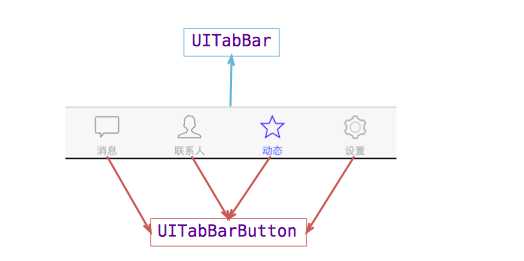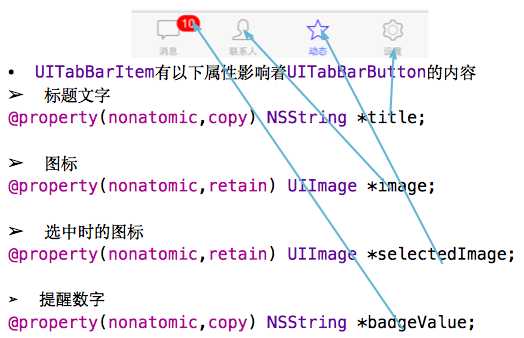标签:
一:UITabBarController的简单介绍:
1.使用步骤:
(1)初始化UITabBarController
(2)设置UIWindow的rootViewController为UITabBarController
(3)创建相应的子控制器(viewcontroller)(让子控制器作为导航控制器的根视图控制器,最外层包装一层导航条)
(4)把子控制器添加到UITabBarController
2:加入方式:(1)[tb addChildViewController:c1];
(2)tb.viewControllers=@[c1,c2,c3,c4];
注意:展示的顺序和添加的顺序一致,和导航控制器中不同,展现在眼前的是第一个添加的控制器对应的View。导航控制器是压栈的过程
3.UITabBar
下方的工具条称为UITabBar ,如果UITabBarController有N个子控制器,那么UITabBar内部就会有N 个UITabBarButton作为子控件与之对应。
注意:UITabBarButton在UITabBar中得位置是均分的,UITabBar的高度为49。
在上面的程序中,UITabBarController有4个子控制器,所以UITabBar中有4个UITabBarButton,UITabBar的结构?大致如下图所示:

2.UITabBarButton
UITabBarButton?面显?什么内容,由对应子控制器的tabBarItem属性来决定
c1.tabBarItem.title=@"消息";
c1.tabBarItem.image=[UIImage imageNamed:@"tab_recent_nor"];

3:详细参考博文:http://www.cnblogs.com/wendingding/p/3775488.html
二:UITabBarController在项目中的应用
1:设置窗口的根视图控制器为CZTabBarController
2:
#import <UIKit/UIKit.h> @interface CZTabBarController : UITabBarController @end #import "CZTabBarController.h" #import "UIImage+Image.h" #import "CZTabBar.h" #import "CZHomeViewController.h" #import "CZMessageViewController.h" #import "CZDiscoverViewController.h" #import "CZProfileViewController.h" #import "CZNavigationController.h" #import "CZUserTool.h" #import "CZUserResult.h" #import "CZComposeViewController.h" @interface CZTabBarController ()<CZTabBarDelegate> @property (nonatomic, strong) NSMutableArray *items; @property (nonatomic, weak) CZHomeViewController *home; @property (nonatomic, weak) CZMessageViewController *message; @property (nonatomic, weak) CZProfileViewController *profile; @end @implementation CZTabBarController #pragma mark - 懒加载存放tabBarItem的数组 - (NSMutableArray *)items { if (_items == nil) { _items = [NSMutableArray array]; } return _items; } - (void)viewDidLoad { [super viewDidLoad]; // 1:添加所有子控制器 [self setUpAllChildViewController]; // 2:自定义tabBar [self setUpTabBar]; //3: 每隔一段时间请求未读数 [NSTimer scheduledTimerWithTimeInterval:2 target:self selector:@selector(requestUnread) userInfo:nil repeats:YES]; } // 请求未读数 - (void)requestUnread { // 请求微博的未读数 [CZUserTool unreadWithSuccess:^(CZUserResult *result) { // 设置首页未读数 _home.tabBarItem.badgeValue = [NSString stringWithFormat:@"%d",result.status]; // 设置消息未读数 _message.tabBarItem.badgeValue = [NSString stringWithFormat:@"%d",result.messageCount]; // 设置我的未读数 _profile.tabBarItem.badgeValue = [NSString stringWithFormat:@"%d",result.follower]; // 设置应用程序所有的未读数 [UIApplication sharedApplication].applicationIconBadgeNumber = result.totoalCount; } failure:^(NSError *error) { }]; } #pragma mark - 设置自定义的tabBar - (void)setUpTabBar { /* 1:self.tabBar所在控制器的tabBar,要想添加自定义的tabBar,需要移除系统自带的tabBar **/ // 自定义tabBar CZTabBar *tabBar = [[CZTabBar alloc] initWithFrame:self.tabBar.frame]; tabBar.backgroundColor = [UIColor whiteColor]; // 设置代理 tabBar.delegate = self; // 给tabBar传递tabBarItem模型 tabBar.items = self.items; // 添加自定义tabBar [self.view addSubview:tabBar]; // 移除系统的tabBar [self.tabBar removeFromSuperview]; } #pragma mark - 当点击tabBar上的按钮调用,并切换视图 - (void)tabBar:(CZTabBar *)tabBar didClickButton:(NSInteger)index { /* 1:self.selectedIndex = index;此行代码很重要,执行此代码才会切换视图 */ if (index == 0 && self.selectedIndex == index) { // 点击首页,刷新 [_home refresh]; } self.selectedIndex = index; } #pragma mark - 点击加号按钮的时候调用 - (void)tabBarDidClickPlusButton:(CZTabBar *)tabBar { /* 1:presentViewController的时候,想要视图有导航条,就让它作为导航控制器的一个根视图控制器 */ // 创建发送微博控制器 CZComposeViewController *composeVc = [[CZComposeViewController alloc] init]; CZNavigationController *nav = [[CZNavigationController alloc] initWithRootViewController:composeVc]; [self presentViewController:nav animated:YES completion:nil]; } #pragma mark - 添加所有的子控制器 - (void)setUpAllChildViewController { /* 步骤: 1:创建所有子控制器的对象,并给每个自控制器外层包装一个导航控制器 2:设置每个子控制器的tabBarItem上得选中未选中图片,还有每个子控制器的标题 2:因为过程都是重复相同的代码,所以抽代码封装成一个方法供外界访问,提供的参数包括:image,selectedImage,title */ // 首页 CZHomeViewController *home = [[CZHomeViewController alloc] init]; [self setUpOneChildViewController:home image:[UIImage imageNamed:@"tabbar_home"] selectedImage:[UIImage imageWithOriginalName:@"tabbar_home_selected"] title:@"首页"]; _home = home; // 消息 CZMessageViewController *message = [[CZMessageViewController alloc] init]; [self setUpOneChildViewController:message image:[UIImage imageNamed:@"tabbar_message_center"] selectedImage:[UIImage imageWithOriginalName:@"tabbar_message_center_selected"] title:@"消息"]; _message = message; // 发现 CZDiscoverViewController *discover = [[CZDiscoverViewController alloc] init]; [self setUpOneChildViewController:discover image:[UIImage imageNamed:@"tabbar_discover"] selectedImage:[UIImage imageWithOriginalName:@"tabbar_discover_selected"] title:@"发现"]; // 我 CZProfileViewController *profile = [[CZProfileViewController alloc] init]; [self setUpOneChildViewController:profile image:[UIImage imageNamed:@"tabbar_profile"] selectedImage:[UIImage imageWithOriginalName:@"tabbar_profile_selected"] title:@"我"]; _profile = profile; } #pragma mark - 添加每一个子控制器 - (void)setUpOneChildViewController:(UIViewController *)vc image:(UIImage *)image selectedImage:(UIImage *)selectedImage title:(NSString *)title { //1:设置每个子控制器的标题(子控制器的标题与tabbar标题只需设置一次 navigationItem决定导航条上的内容 导航条上的内容由栈顶控制器的navigationItem决定 vc.title = title; //2:设置每个字控制器tabBarItem vc.tabBarItem.image = image; vc.tabBarItem.selectedImage = selectedImage; // 3:保存tabBarItem模型到数组 [self.items addObject:vc.tabBarItem]; // 4:将子控制器作为导航控制器的根视图控制器 CZNavigationController *nav = [[CZNavigationController alloc] initWithRootViewController:vc]; //5:添加子控制器 [self addChildViewController:nav]; } @end
标签:
原文地址:http://www.cnblogs.com/learningios/p/5372240.html